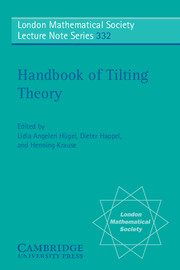Book contents
- Frontmatter
- Contents
- 1 Introduction
- 2 Basic results of classical tilting theory
- 3 Classification of representation-finite algebras and their modules
- 4 A spectral sequence analysis of classical tilting functors
- 5 Derived categories and tilting
- 6 Hereditary categories
- 7 Fourier-Mukai transforms
- 8 Tilting theory and homologically finite subcategories with applications to quasihereditary algebras
- 9 Tilting modules for algebraic groups and finite dimensional algebras
- 10 Combinatorial aspects of the set of tilting modules
- 11 Infinite dimensional tilting modules and cotorsion pairs
- 12 Infinite dimensional tilting modules over finite dimensional algebras
- 13 Cotilting dualities
- 14 Representations of finite groups and tilting
- 15 Morita theory in stable homotopy theory
- Appendix: Some remarks concerning tilting modules and tilted algebras. Origin. Relevance. Future.
8 - Tilting theory and homologically finite subcategories with applications to quasihereditary algebras
Published online by Cambridge University Press: 25 May 2010
- Frontmatter
- Contents
- 1 Introduction
- 2 Basic results of classical tilting theory
- 3 Classification of representation-finite algebras and their modules
- 4 A spectral sequence analysis of classical tilting functors
- 5 Derived categories and tilting
- 6 Hereditary categories
- 7 Fourier-Mukai transforms
- 8 Tilting theory and homologically finite subcategories with applications to quasihereditary algebras
- 9 Tilting modules for algebraic groups and finite dimensional algebras
- 10 Combinatorial aspects of the set of tilting modules
- 11 Infinite dimensional tilting modules and cotorsion pairs
- 12 Infinite dimensional tilting modules over finite dimensional algebras
- 13 Cotilting dualities
- 14 Representations of finite groups and tilting
- 15 Morita theory in stable homotopy theory
- Appendix: Some remarks concerning tilting modules and tilted algebras. Origin. Relevance. Future.
Summary
Introduction
Tilting theory is a central topic in the representation theory of algebras and related areas, as illustrated by the diverse contributions to this volume. One of the important aspects has been connections with homologically finite subcategories, which is a common term for contravariantly, covariantly and functorially finite subcategories. One main result along these lines is the following correspondence theorem.
For an artin algebra Λ of finite global dimension there is a one-one correspondence between isomorphism classes of basic cotilting Λ –;modules and contravariantly finite resolving subcategories of the category of finitely generated Λ-modules.
This result has interesting applications to the quasihereditary algebras introduced in [18], with the category of modules having standard filtration as the relevant subcategory [44]. Through the above result, there is an associated tilting module, which since the early nineties has had great influence in the theory of algebraic groups and Lie algebras (see [22] and the references there).
This paper is centered around the above correspondence theorem. Actually, we discuss a more general version valid beyond finite global dimension, which has applications to generalizations of quasihereditary algebras.
We start with the basic setup in Chapter 1. First we discuss some generalities on correspondences between modules and subcategories, or pairs of subcategories. Then we recall results from tilting theory which are relevant for our discussions in this paper, and we give a brief introduction to the theory of contravariantly and covariantly finite subcategories [11] [12]. We also discuss some connections between the topics.
- Type
- Chapter
- Information
- Handbook of Tilting Theory , pp. 179 - 214Publisher: Cambridge University PressPrint publication year: 2007
- 6
- Cited by



